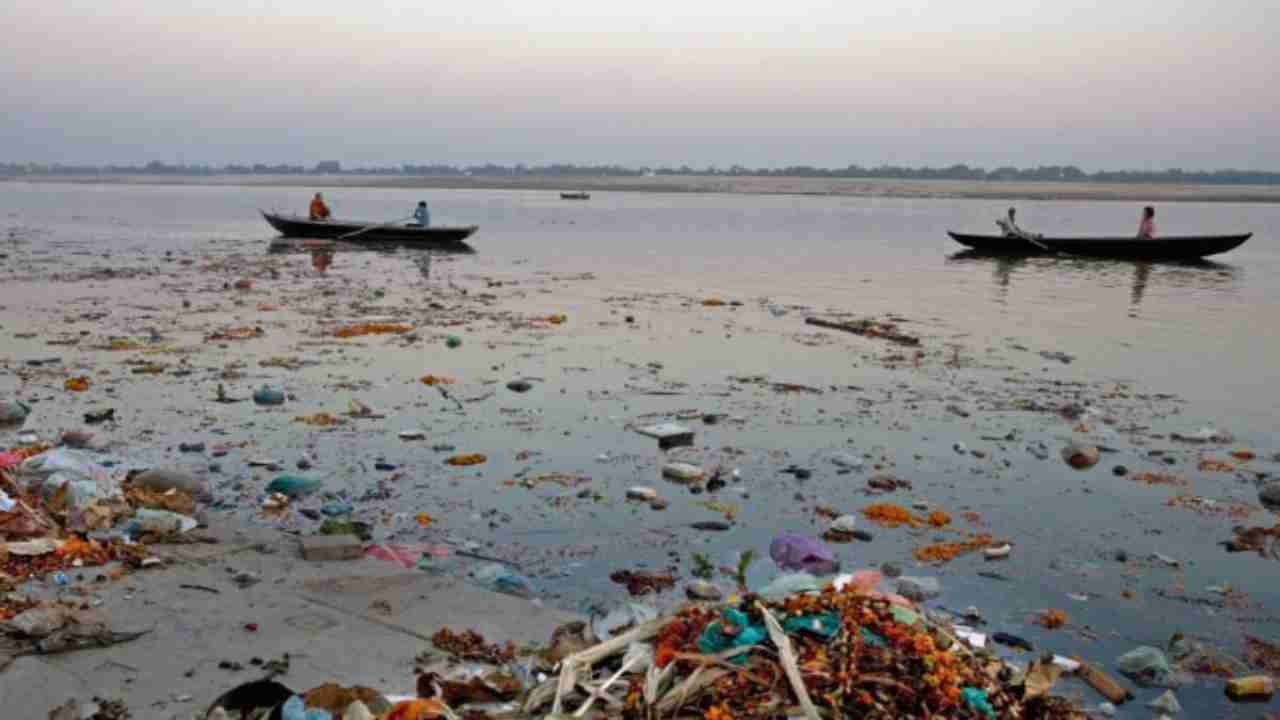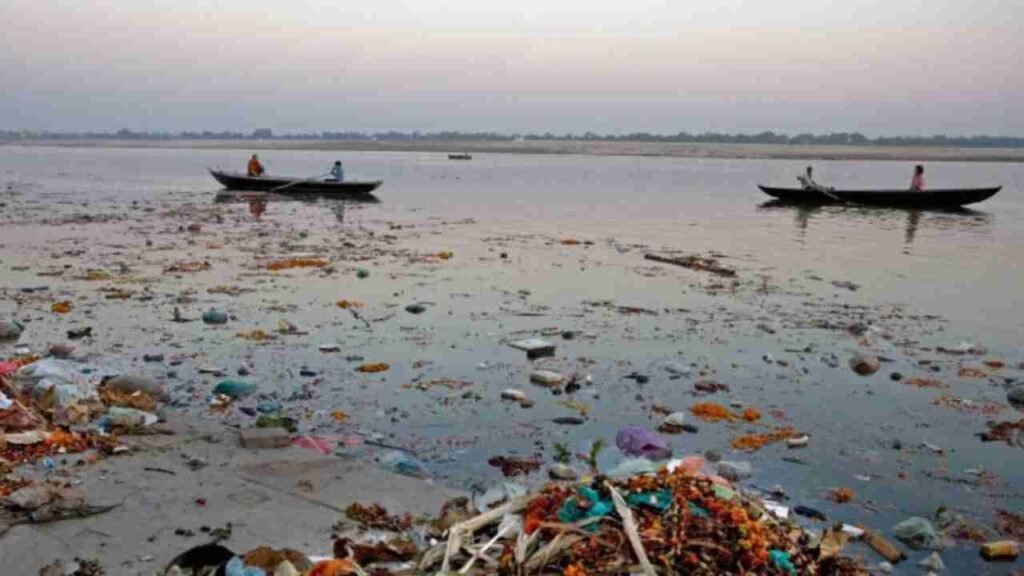The Ganga, revered as the holiest river in India, holds a significant place in the hearts and minds of millions. However, beneath its spiritual aura lies a stark reality – pollution. Despite its cultural and religious significance, the Ganga is one of the most polluted rivers globally. While many continue to take baths in its waters as a religious ritual,

Here are five compelling reasons why you should avoid bathing in the Ganga.
- Chemical Contamination: Industrial effluents, agricultural runoff, and untreated sewage are major contributors to the chemical contamination of the Ganga. These pollutants contain harmful substances such as heavy metals, pesticides, and fertilizers, posing serious health risks to those who come in contact with the water. Bathing in such contaminated water can lead to skin diseases, respiratory issues, and even long-term health complications.
- Bacterial Infection: The untreated sewage discharged into the Ganga serves as a breeding ground for various disease-causing bacteria and pathogens. Waterborne illnesses like cholera, typhoid, and gastroenteritis are prevalent in areas where the river water is extensively polluted. Immersing oneself in such contaminated water increases the risk of contracting these infections, leading to severe health consequences.
- Toxic Foam: In recent years, alarming incidents of toxic foam formation have been reported in the Ganga, particularly in urban stretches heavily polluted by industrial waste and sewage. This foam, comprised of harmful chemicals and detergents, not only indicates severe pollution but also poses immediate health hazards upon contact. Bathing in water covered with toxic foam can cause skin irritation, allergic reactions, and respiratory distress.
- Plastic Pollution: Plastic waste, including bottles, bags, and packaging materials, has become pervasive in the Ganga, degrading its water quality and endangering aquatic life. Bathing amidst floating plastic debris not only spoils the spiritual experience but also increases the risk of physical injuries and infections. Moreover, microplastics present in the water can enter the body through skin absorption, leading to adverse health effects over time.
- Loss of Cultural Significance: The Ganga holds immense cultural and religious significance for millions of people, serving as a symbol of purity and spirituality. However, rampant pollution has tarnished its sacred image, undermining its role as a source of spiritual nourishment. By continuing to bathe in polluted waters, we not only compromise our health but also perpetuate the degradation of a cultural heritage that transcends generations.
Conclusion:
While the Ganga continues to be venerated for its spiritual significance, it is imperative to acknowledge and address the severe pollution plaguing its waters. Avoiding bathing in the Ganga is not only a matter of personal health but also a step towards preserving a vital natural resource and cultural heritage. As responsible citizens, we must advocate for cleaner waterways and sustainable practices to ensure the preservation of our rivers for future generations. Let us strive to restore the purity of the Ganga and honor its legacy as a symbol of divine grace and life-giving force.
Top 20 FAQs About River Water Pollution: 5 Reasons Why You Should Avoid Taking a Bath in the Ganga
- Why is the Ganga considered polluted? Answer: The Ganga is polluted due to various factors including industrial waste, agricultural runoff, and untreated sewage being discharged into its waters.
- What are the major sources of pollution in the Ganga? Answer: Major sources of pollution include industrial effluents, agricultural runoff containing pesticides and fertilizers, and untreated sewage from urban areas.
- Is it safe to bathe in the Ganga? Answer: No, it’s not safe to bathe in the Ganga due to high levels of chemical contamination, bacterial infection risks, toxic foam formation, and plastic pollution.
- What health risks are associated with bathing in the Ganga? Answer: Health risks include skin diseases, respiratory issues, bacterial infections (such as cholera and typhoid), allergic reactions, and long-term health complications due to exposure to pollutants.
- Why is chemical contamination a concern in the Ganga? Answer: Chemical contamination in the Ganga poses health risks as pollutants like heavy metals, pesticides, and fertilizers can cause various ailments upon contact with the skin or ingestion.
- What is the significance of the toxic foam in the Ganga? Answer: Toxic foam indicates severe pollution in the Ganga, consisting of harmful chemicals and detergents. Contact with this foam can lead to skin irritation, allergic reactions, and respiratory distress.
- How does plastic pollution affect bathing in the Ganga? Answer: Plastic pollution in the Ganga poses physical hazards, including injuries from floating debris. Moreover, microplastics present in the water can enter the body through skin absorption, leading to health issues over time.
- What measures are being taken to address pollution in the Ganga? Answer: Various initiatives such as the Namami Gange project have been launched to address pollution in the Ganga, including sewage treatment plants, river surface cleaning, and awareness campaigns.
- Can traditional rituals be performed in the Ganga despite pollution concerns? Answer: While traditional rituals hold cultural significance, precautions should be taken to minimize direct contact with polluted water during such practices.
- How does pollution in the Ganga impact aquatic life? Answer: Pollution in the Ganga affects aquatic life by disrupting ecosystems, causing habitat degradation, and endangering species through contamination and plastic ingestion.
- What role do industries play in polluting the Ganga? Answer: Industries contribute to Ganga pollution by discharging untreated effluents containing harmful chemicals and heavy metals, contaminating the water and endangering both human health and the environment.
- Are there any regulations in place to prevent pollution in the Ganga? Answer: Yes, several regulations and environmental laws exist to regulate pollution discharge into the Ganga, but enforcement and compliance remain challenges.
- How can individuals contribute to reducing pollution in the Ganga? Answer: Individuals can contribute by adopting sustainable practices, reducing plastic usage, properly disposing of waste, and supporting initiatives aimed at cleaning and restoring the Ganga.
- Is it safe to consume water from the Ganga? Answer: No, it’s not safe to consume water from the Ganga without proper treatment due to contamination risks.
- What long-term effects does bathing in polluted water have on health? Answer: Long-term effects may include chronic illnesses, weakened immune system, and increased risk of cancer due to prolonged exposure to pollutants.
- Can pollution in the Ganga be reversed? Answer: With concerted efforts, pollution in the Ganga can be mitigated and its water quality improved, but it requires cooperation from various stakeholders and sustained action.
- How does pollution in the Ganga affect surrounding communities? Answer: Pollution in the Ganga affects surrounding communities by jeopardizing public health, livelihoods dependent on the river, and cultural practices associated with it.
- What impact does pollution in the Ganga have on agriculture? Answer: Pollution in the Ganga can contaminate agricultural lands through irrigation, affecting soil quality and crop health, thereby impacting agricultural productivity and food security.
- Are there alternative ways to perform religious rituals without directly using Ganga water? Answer: Yes, alternative methods such as symbolic offerings or using clean water from designated sources can be adopted to perform religious rituals without directly using polluted Ganga water.
- How can tourists and pilgrims contribute to preserving the Ganga’s purity? Answer: Tourists and pilgrims can contribute by raising awareness about the importance of preserving the Ganga, practicing responsible tourism, and supporting sustainable development initiatives in the region.
Register for My Upcoming Masterclass HERE
See You in the Live Masterclass
Sunil Chaudhary stands as a preeminent global Leading digital coach, boasting a diverse clientele hailing from over 50 nations. Renowned for his prowess as an exemplary SEO expert, business automation coach, and landing page authority, Chaudhary also holds the distinction of being esteemed as the finest business coach in India. Beyond technical domains, he imparts invaluable insights into mindset, success, and life skills, thus encompassing a holistic approach to mentorship.








